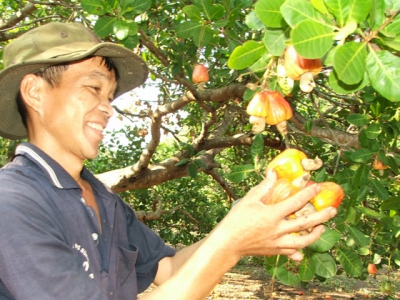Cashew industry exports more than US$31 billion over the past 30 years

Cashew exports have brought an impressive US$31 billion turnover over past 30 years since the establishment of the Vietnam Cashew Association.
Cashew harvest in Binh Phuoc. Photo: TL.
On Nov 23, 1990, the Vietnam Cashew Association (Vinacas ) was established.
It was considered a historic turning point of the Vietnamese cashew industry, said Mr. Pham Van Cong, President of Vinacas. Over the past 30 years, the cashew industry has made breakthrough achievements.
From a country that exported raw cashew in small quantities, Vietnam has become the leading exporter of cashew nuts in the world. For 15 consecutive years, from 2006-2020, Vietnamese cashew industry has always maintained its number one position in cashew nut export and completely mastered technology and processing equipment. Up to now, the cashew industry has exported cashew kernels to more than 90 countries and territories, accounting for around 80% of cashew kernel exports in the world.
Vinacas has made a strong impression on the development of Vietnam's cashew industry over the past 30 years. Since its establishment in 1990 with only 12 founding members, the number of members has now reached more than 500. In addition, Vinacas is a founding member of the Global Cashew Council (GCC) and has been awarded the Third and Second Class Labor Medal by the State President; Emulation flag by the Government; and many certificates of merit and emulation flags by Ministry of Industry and Trade and the Ministry of Agriculture and Rural Development.
Regarding the prospects of the cashew industry in the coming time, Mr. Pham Van Cong said that the Vietnamese cashew industry is facing both new opportunities and new challenges. It now has to choose between: invest in technology innovation to remain its position in global cashew kernel exports, or both invest in cashew kernels and allocate resources for deep processing, implementing the "Second Revolution" and enhancing Vietnam's position in the global cashew value chain.
In order to take advantage of opportunities and overcome challenges, Vinacas is planning to propose to the Government the "Strategy for the development of Vietnam's cashew industry in the new situation", aiming at two main goals: developing deep processing to meet the diverse needs of the world market and develop quality and efficient material areas.
The hallmarks of cashew exports over the past 30 years:
- In 1990, Vietnam started to export cashew nuts with the annual export volume of 286 tons, worth US$ 1.4 million.
- In 1995, for the first time, the export volume of cashew kernel exceeded 10,000 tons (reaching 15,000 tons), worth US$90 million.
- In 1996, for the first time, the export value of cashew nuts exceeded US$ 100 million (reaching US$ 110 million).
- In 2004, for the first time, the export volume of cashew nuts exceeded 100 thousand tons (reaching more than 105 thousand tons), worth US$ 436 million.
- In 2006, for the first time, Vietnam rose to the world’s number 1 position in cashew nut export when it reached nearly 127 thousand tons, worth US$ 504 million.
- In 2010, for the first time, cashew kernel exports exceeded US$ 1 billion (reaching US$ 1,135 billion).
- In 2012, for the first time, cashew kernel export exceeded 200,000 tons.
- In 2015, for the first time, cashew nut exports exceeded 300,000 tons (reaching 328,000 tons) and US$ 2 billion (reaching $ 2,357 billion).
- In 2017, for the first time, cashew kernel exports exceeded US$ 3 billion (reaching US$ 3.62 billion).
- In 2019, for the first time, cashew kernel exports exceeded 400 thousand tons (reaching 460 thousand tons).
- It is expected that in 2020, cashew kernel export will reach 450 thousand tons, worth US$ 3.28 billion.
From 1990 to the end of 2020, the cashew export is estimated to reach over 4.6 million tons, with a total value of more than US$ 31 billion.
Related news
 Fruits provide important input for industrial production in Dong Thap
Fruits provide important input for industrial production in Dong Thap Fruit farms in the southern province of Dong Thap have provided important input for industrial production and helped increase value-added
 Vietnamese vegetables and fruits are massively exported to Thailand
Vietnamese vegetables and fruits are massively exported to Thailand Thailand is the biggest fruit and vegetable exporter in South-East Asia. However, this year, Vietnamese fruits and vegetables exported to Thailand
 Citrus trees need planning
Citrus trees need planning Having been growing fast in area, yield and quality in the past few years, it is now not easy to find a sustainable direction for citrus trees.